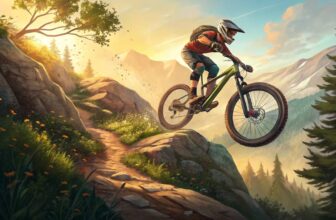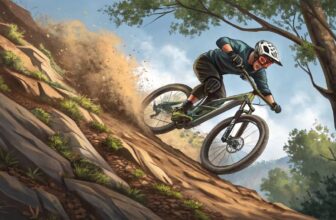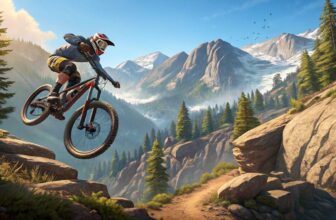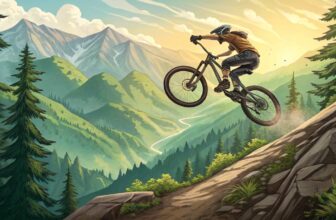Understanding Terrain Types
Mountain biking isn’t just a ride; it’s an adventure with an all-you-can-eat buffet of terrains, each throwing its own curveballs your way. Picking up on these secrets ain’t just gonna make you a more confident rider, it’ll boost your skills like a morning espresso. So, let’s roll through five wild terrain types: rock gardens, slickrock trails, hard pack dirt trails, snow-covered routes, and mud and clay tracks.
Navigating Rock Gardens
It’s like nature’s obstacle course! Rock gardens are gritty sections full of bumps and grinds. You gotta soft-paw those handlebars to soak up shock while keeping eagle eyes on the smoothest trail through the stones.
Rock Garden Survival Kit:
- Dance with your bike by loosening up your grip
- Keep a nice steady speed to ride ’em bumps easy
- Scout that smooth path like Indiana Jones
- Brush up on those tech moves, build the confidence
Tap into more about tackling these beastly terrains with our articles on mtb body position and mtb technical climbing.
Riding Slickrock Trails
Imagine a grippy rollercoaster carved out of sandstone and limestone! Slickrock trails practically glue your bike to the ground, making those scary ups and downs feel like a joyride. You gotta let some air out those tires for extra cling, lean like a pro, and let the rubber’s grip reassure you.
Secrets of Slickrock Riding:
- Deflate those tires a smidge to stick like glue
- Body weight is key—use it to steer your ride
- Lean like you mean it on cursed curves
- Trust the tires; they know their job
Stay on top of your game and get your bike smoooooth sailing with our guide on mtb tire pressure.
Exploring Hard Pack Dirt Trails
Hard pack dirt—like a heavenly highway beneath those wheels. When dry, it’s rad, but when wet, it turns into a slippery game of slip ‘n slide. Speed is your buddy here, and having tires that grip is like wearing sneakers on a basketball court.
Hard Pack Know-How:
- Keep up the speed for a tight ride
- Adapt your moves for rogue gravel
- Pick tires with a grip like an iron hand
- Balance like a tightrope walker to dodge rock missiles
Ensure your steed is always ready for these trusty tracks with some mountain bike maintenance.
Adventuring in Snow-Covered Routes
Let’s blast the chill! Snow routes call for a chunky bike—say hello to fat tires! Dropping tire pressure here is gonna glue you to the ground. Ride gently, pedal smooth, and brake like you’re floating on air, but gear up for a sweat, this route’s no stroll!
Snow Riding 101:
- Fat bikes aren’t just a gimmick—they float!
- Lower than pressure; make it a soft landing
- Be gentle on the pedals and brakes
- Prep to shed some layers as you heat up
Dive more into winter wonders with our guide on optimal gravel bikes and tires.
Conquering Mud and Clay Trails
Nothing like a bit of mud to put hair on your chest! Riders need to use their weight to stay balanced and choose tires with teeth to bite into that mushy stuff. At times, you might even find yourself hiking it to avoid messing up the trail.
Mud Riding Hacks:
- Stay level with weight centered
- Steady pacing is safe pacing through the sludge
- Get tires with a mean bite to keep slipping at bay
- Sometimes two feet are better than two wheels in the muck
Find more safe-riding tricks and gear tips in our posts on mountain biking safety tips and the best mountain bikes under 1000.
Nailing these terrains is a game-changer for riders of all skill levels. Knowing what’s up ahead and dialing in your bike wizardry is gonna translate into mad fun and safety on your next adventure.
Mastering Special Skills
Taking your mountain biking up a notch requires some nifty moves, especially when you’re dealing with something like rock gardens that could give a mountain goat pause. You’ll find neat tricks in this section like trackstands and bailing. Plus, we’ll chat about how flat pedals might just be your new best friend, and how to dance your bike down skinnies, including the twisty or raised ones.
Trackstand and Bailing Techniques
Getting the hang of a trackstand—stopping dead and staying upright—gives you that Zen-like balance every biker craves when you’re dodging the gnarly stuff. Basically, you’re holding still while your bike’s wheels do a silent tap dance. And Stone says this nifty move does wonders for the ego and control meter.
Bailing out is your safety net when things get too hairy. This skill kicks in when you gotta hop off your bike like it’s a hot stove, keeping your limbs safe from harm when the trail turns into a tricky beast.
Benefits of Using Flat Pedals
Flat pedals are a godsend, especially if skinnies or rock gardens give you the heebie-jeebies. They make quick getaways a breeze and give your legs room to work their magic on balance. If you’re feeling fancy, a dropper post lets you tweak your saddle height on the fly, making bailing even smoother.
| Feature | Advantage |
|---|---|
| Flat Pedals | Quick step-off, leg power boost |
| Dropper Post | Swift saddle height control |
Dig into our mountain bike pedal types guide for the full lowdown on pedal pros and cons.
Techniques for Approaching Skinnies
When it comes to skinnies—those thin elevated tracks or logs—it’s all about skill and poise to keep you moving without a hitch. Stone’s got some golden advice for tackling these:
- Eye on the Prize: Glance ahead where you want to roll, not what you’re dodging.
- Steady Pace: Keep your speed just right to stay upright.
- Easy Does It: Movements should be slow and smooth to keep your balance cozy.
With these tricks up your sleeve, you’ll glide across skinnies like a pro.
Navigating Curved and Elevated Skinnies
Curved or raised skinnies are a whole new ball game, demanding even more cool-headed control. Stone swears by these tips for mastering them:
- All In: Trust your instincts and commit to the path.
- Balanced Stance: Keep your torso firm and centered over the frame.
- Footing: Level those pedals to keep on the straight and narrow.
Put in the practice on skinnies, and you might just find you’re smoother on all terrains. Find more cool tips on bike positioning and balance.
With these skills under your belt, you’ll charge at rock gardens and any tough terrain like you’ve got springs in your heels. For more biking hacks, dive into our articles on mountain biking basic skills, mtb suspension setup, and the mountain bike brakes showdown.
Riding Variations
Riding in Sandy Conditions
Rolling through sand? It’s a wild ride, no doubt. Sand might look inviting, but it’s got a mind of its own, squirming and slipping beneath your wheels. To keep from kissing the sand, it’s smart to maintain a steady clip and dodge those sharp turns. Fat tire bikes are a solid choice here, perfect for beachy escapes or sandy trails. Those chunky tires grip better, giving you the extra edge.
| Terrain Type | Recommended Bike | Key Features |
|---|---|---|
| Sandy Conditions | Fat Bike | Big Tires, Low Air Pressure |
For the best ride, let a little air out. Lower tire pressure means more contact with the ground, and that helps with balance. Check out the best MTB tire pressure for wherever you’re biking.
Exploring Trails on Fat Bikes
Fat bikes, they’re like the Swiss Army knives of the biking world—handling everything from snowy paths to gritty trails. With their wide tires and larger frames, these bikes make riding over uneven surfaces a breeze. Yep, they’re up for the messy stuff: sand, grass, gravel, and rocks.
| Terrain Type | Features of Fat Bikes |
|---|---|
| Snow | Rocks Steady |
| Sand | Grips Like a Dream |
| Gravel | Smooth Ride |
| Rocks | Extra Control |
| Muddy Trails | Stays Firm |
Fat bikes made a statement after epic events like the Iditabike race in Alaska, proving just how much their wide rims can handle. Check out our tips on keeping your bike at its best with our MTB suspension setup guide.
Discovering Different Mountain Biking Styles
Mountain biking comes in many flavors, and each one needs its own gear and setup. Knowing the different styles helps you pick the right ride and equipment.
- Cross Country (XC): All about mixing uphill puff and downhill fun on smooth trails. XC bikes are built light and fast, which is great for those who love a good climb paired with downhill zoom.
- Trail Riding: Think of it as the jack-of-all-trades. These bikes can climb and descend, perfect for those on-the-fly challenges.
- Enduro: It’s a thrill-seeker’s dream with timed speed stages downhill and the chill of uphill rides. Sturdy bikes with serious suspension are your best bet here.
- Downhill (DH): Gravity at its finest—racing down steep, jump-filled tracks. Strong, heavy-duty bikes help soak up those hardcore landings.
| Style | Features | Ideal Bike |
|---|---|---|
| Cross Country | Mix of Climbing & Descending | Light XC Bike |
| Trail Riding | All-Terrain Ready | Flexible Trail Bike |
| Enduro | Speed Challenges, Climb | Tough Enduro Bike |
| Downhill | Steep & Fast | Rugged DH Bike |
Curious about where to ride next? See our mtb trail ratings guide for spots that fit your style. And don’t forget to gear up with the necessary mountain biking essentials for a safe adventure.
Expert Riding Tips
Getting the hang of biking off-road involves more than just pedaling. To really rock those trails, you need a bunch of skills and know-how that’ll ramp up your mountain biking adventures. We’ve gathered some top tips for cruising those trails like a pro, keeping your balance in check, and tackling those uphill and downhill rides.
Trail Ratings and Challenges
So, mountain bike trails aren’t just random dirt paths—there’s a whole system to let you know what you’re in for. Here’s a quick look at the usual categories you’ll see:
| Trail Rating | Difficulty Level | Key Features |
|---|---|---|
| Green | Easy | Nice, gentle slopes and pathways as wide as a country road |
| Blue | Intermediate | Some hills and small hurdles to keep you on your toes |
| Black | Difficult | Heart-pumping steep slopes and technical bits to challenge you |
| Double Black | Extremely Difficult | Brace yourself for extremely steep and technical terrain |
These ratings are like your personal trail concierge, showing you exactly where your skills fit. Check out our full scoop on mtb trail ratings to get to grips with these.
Body Positioning and Balance
Nailing the right position and balance is your ticket to staying in control and keeping safe out there. Think of it like this: you’re the captain and the bike is your ship. Keep your knees and elbows a bit bent to stay nimble, and do your best to balance your weight between the front and back wheels. It’s like dancing over rocks and ruts.
Here’s the lowdown:
- Keep your eyes trained ahead to spot any trouble up the track
- Loosen up and move back a smidge when you’re headed downhill
- Make your front tire stick by leaning forward when you’re climbing
For more on nailing that stance, take a peek at our MTB body position guide.
Climbing and Descending Techniques
Climbing and the trip back down need some special moves, but mastering these can save you a lot of energy and keep you safe.
Climbing Techniques:
- Keep your pedaling smooth and steady
- Find the gear that keeps you moving without burning out
- Just barely shift your weight forward to keep that front wheel in check
Descending Techniques:
- Get that weight balanced just right between the front and back
- Use the brakes gently to control speed without leaving skid marks
- Keep a chill grip on the handlebars to let your arms absorb any shocks
Curious about how to conquer those steeper climbs? We’ve got the details in our mtb technical climbing article. And to stop like a pro, our guide on mtb braking techniques has all the good stuff.
By taking these tips to heart, you’ll boost your biking skills and tackle trails with newfound gusto. For a deep dive into more biking wisdom, check out our linked guides and pump up your game!
Choosing the Right Gear
When you’re hitting those rocky backroads and crunching through rough trails, picking the right gear is a game-changer for any mountain biker out there.
Optimal Gravel Bikes and Tires
Riding on gravel—whether it’s a dry stretch of dirt or a scatter of loose stones with tricky rock gardens—demands the right kind of bike and tires. We’ve got your back with this handy guide to steer you through that decision-making maze.
Gravel Bikes
Gravel bikes are like the Swiss Army knives of cycling—they’re built to handle a bit of everything. They don’t just get you through any terrain; they do it comfortably on long rides. Here’s what to keep in mind:
- Frame Material: Most often, you’ll come across aluminum, carbon fiber, and steel. Carbon fiber stands out for being lightweight and does a great job at soaking up bumps.
- Geometry: Spy those frames with a chill geometry; they’ll keep things steady and comfy when the ride gets rough.
- Tire Clearance: Check if the frame can fit wider tires—up to 45mm or bigger—for extra grip and stability.
Gravel Tires
Tires are your ticket through different gravel paths. They come in three flavors, based on the knob size: Slick/Semi-Slick, Small Knob, and Big Knob tires. Not just any tire will do; picking the right one can transform your ride.
| Tire Type | Description | Best Use |
|---|---|---|
| Slick/Semi-Slick | Hardly any tread | Flat dirt paths and smooth roads |
| Small Knob | Little and jam-packed knobs | Mixed trails where speed meets adaptability |
| Big Knob | Huge, spaced-out knobs | Loose terrain, mud, and rocky spots |
Picking the right tire type is like setting up the perfect playlist for the ride. The Continental Terra Speed is a favorite in the small knob category, cruising fast but gripping hard, even on the deeper gravel typical in rock gardens (Class 4).
Gravel Road Classifications
Knowing your gravel road types helps choose the right tires:
| Class | Surface Type |
|---|---|
| Class 1 | Smooth dirt topped with tiny gravel |
| Class 2 | Gravelly with the odd rock or root thrown in |
| Class 3 | Bigger rocks, deeper grooves, bulkier hurdles |
| Class 4 | It’s a rock garden show: ultra-rocky and technical |
If you’re gearing up for rock gardens (Class 4), those tires with big knobs are your best pals for grip and steadiness.
Personalizing your bike setup is the name of the game, newbie or not. For more advice, see our pieces on mountain bike sizing and MTB tire pressure.
By selecting the right gravel bike and tires, you can confidently tackle rock gardens and gnarly terrains without breaking a sweat. For more wisdom on biking gear, give our guides on mountain bike maintenance and mtb gear ratios a whirl.




